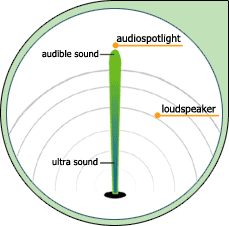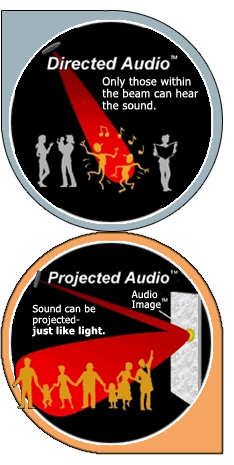Put sound where you want it.

The directivity (narrowness) of any wave producing source depends on the size of the source, compared to the wavelengths it generates. Audible sound has wavelengths ranging from a few inches to several feet, and because these wavelengths are comparable to the size of most loudspeakers, sound generally propagates omnidirectionally. Only by creating a sound source much larger than the wavelengths it's producing can a narrow beam be created.
Clearly, having loudspeakers twenty metres wide is not very
useful.
therefore ...
to make a
narrow beam of sound from a small acoustic source, we instead
generate only ultrasound.
The ultrasound, whose wavelengths are only a few millimetres long, are much smaller than the source, and consequently travel in an extremely narrow beam.
Of course, the ultrasound, which contains frequencies far outside our range of hearing, is completely inaudible. But as the ultrasonic beam travels through the air, the inherent properties of the air causes the ultrasound to distort (change shape) in a predictable way. This distortion gives rise to frequency components in the audible bandwidth, which can be accurately predicted, and therefore precisely controlled. By generating the correct ultrasonic signal, we can create, within the air itself, essentially any sound desired.
Note that the source of sound is not the physical device you see, but the invisible beam of ultrasound, which can be many meters long. This new sound source, while invisible, is very large compared to the audio wavelengths it's generating. So the resulting audio is now extremely directional, just like a beam of light.

Often incorrectly attributed to so-called "Tartini tones", the technique of using high-frequency waves to generate low-frequency signals was in fact pioneered by physicists and mathematicians developing techniques for underwater sonar over forty years ago. Over the past two decades, many others have attempted – and failed – to use this technique to make a practical audio source.
Through a combination of careful mathematical analysis and
engineering insight, the Audio Spotlight sound system has become the
very first, and still the only, sound beam system which generates
low-distortion, high quality sound in a reliable, professional
package.
The technique of using a nonlinear interaction of high-frequency waves to generate low-frequency waves was originally pioneered by researchers developing underwater sonar techniques dating back to the 1960's 1. These early acoustics researchers successfully derived the formal mathematical basis for this effect, and developed innovative sonar systems with more directivity and bandwidth than would otherwise be available. They called this device a parametric array.
In 1975, the first publication 2 appeared which demonstrated that these nonlinear effects indeed occur in air. While these researchers had not attempted to reproduce audio, they nonetheless proved that such a device may be possible.
Over the next two decades, several large companies, including Matsushita (Panasonic), NC Denon, and Ricoh attempted to develop a loudspeaker based on this principle, and published a paper describing one attempt in 1983 3. While they were successful in producing some sort of sound, problems with cost, feasibility, and extremely high levels of distortion (>50% THD) caused the almost total abandonment of the technology by the end of the 1980's.
While a graduate student developing '3D Audio' at Northwestern University in the late 1990's, Joseph Pompei had similar ideas of using ultrasound as a loudspeaker, largely to overcome deficiencies he saw with traditional methods of sound reproduction. After performing extensive research on the idea, he discovered the large body of knowledge in the field of nonlinear acoustics, as well as the earlier attempts at using ultrasound as an audible source. Soon after arriving at MIT, his insight led him to identify – and subsequently rectify – the barriers which had plagued the earlier researchers.Through a combination of careful mathematical analysis and solid engineering, he was able to construct the very first, and still only, practical, high-performance audio beam system 4.
1 Westervelt, P. J., JASA v35 535-537 (1963)
2 Bennett,
M. B., and Blackstock, D. T., JASA v57 562-568 (1975)
3 Yoneyama,
M., et al., JASA v73 1532-1536 (1983)
4 Pompei, F. J., Proc.105th
AES Conv, Preprint 4853
(1998)
Manufactured exclusively by Holosonic Research Labs, Inc., of Watertown, Massachusetts ©2002 Holosonic Research Labs, Inc.